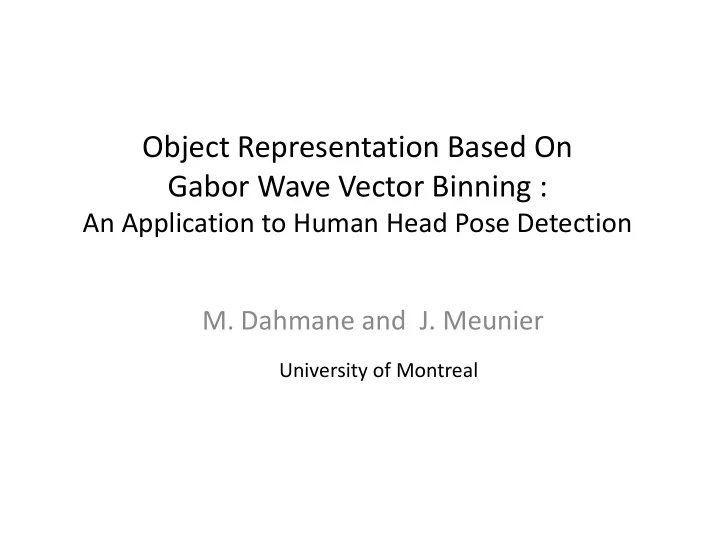

Object Representation Based On Gabor Wave Vector Binning : An Application to Human Head Pose Detection M. Dahmane and J. Meunier University of Montreal
Introduction • Head pose is important: – Inferring important non verbal information – Focus of attention – Agreement disagreement – People nod, confusion etc.
Computerized head pose extraction • Difficulties – Identity and Facial dynamics • Approaches – Geometric : exploit properties that influence the human pose. • Sensitive to the location of facial points – Appearance-based : • Naturally avoid the problem of precise and stable localisation • Need a suitable descriptors
A. Histogram of oriented gradient Cell Cell spacing stride Divide the detection window • into small cells Integrate over each cell, the Block • magnitude of the edge gradient for each orientation bin Block spacing stride Normalize the local histogram • over the four-cells block
B. The Gabor wave vector binning • Gabor wave vector binning based descriptors consist on features generated by : – wavelet transform corresponding to a set of selected wave vectors (ie. orientations and scales)
Gabor wave vectors • The Gabor wavelet transform family is defined as: where Commonly, we have μ= {0..7} and ν {0..4} defining 40 wave vectors.
Gabor wave vector binning • The Basic key idea : – shapes • can be learned from local window • using the spatial distribution of magnitude over different frequencies and orientations. 1. A first–order image gradients is used as salient image locations 2. GWT is processed on salient pixels 3. An image window is used to evaluate local histograms of GWT magnitude responses
The underlying motivation for using Gabor-based descriptors • Consistency with intrinsic characteristics of face images. • Gabor pyramid filtering maintains: – continuity in the spatial frequency of the Gabor feature – detection ability.
POINTING’04 dataset. The head pose database consists of 93 images of 15 persons.
Technical implementation • We used a detection window with 100×40 pixels size. • We have to deal with the alignment problem by searching for the eyes region over the entire image. • The detection window is partitioned into 8 by 4 cells of 12 × 10 pixels.
Technical implementation (2) • The voting strategy is based on the Gabor magnitudes • Magnitudes are collected into 40 histogram bins (wave vector � bin). • Histograms are then integrated over the cell.
Technical implementation (3) • For each block of 2×2 neighboring cells the histograms are concatenated into a block- histogram . • The resulted block-histograms were concatenated into a single (1280 dim) feature vector
SVM as base learners of poses. • For the multiclass SVM, we used RBF-kernel : • SVM parameters selection ? – We used a empirical epoch-based strategy to determine : • Parameters γ and C.
SVM kernel parameters selection • We select the optimal tuple ( γ , � ) corresponding to the epoch with – highest training accuracy – and a reasonable number of SVs.
SVM kernel parameters selection (2) The SVM parameters evolution over Stabilization of the number of training epochs support vectors from epoch 25
• Performances of different pose detection techniques on POINTING’04 setup. Mean absolute error (°) Classification accuracy (%) Yaw Pitch yaw pitch Human 11.8 9.4 40.7 59.0 Voit et al. 12.3 12.7 - - Tu et al. 14.1 14.9 55.2 57.9 Gourier et al. 10.1 15.9 50.0 43.9 Our method 5.7 5.3 65.0 73.3
Some pose ambiguity problems
Proposed descriptors vs. HoG performance comparison Mean absolute Classification error (°) accuracy (%) Yaw Pitch yaw pitch HoG 5.6 6.3 66.4 70.7 ±0° Our feature set 5.7 5.3 65.0 73.3 HoG 0.9 3.7 97.5 88.1 ±15° Our feature set 0.9 2.5 97.5 91.8
Continuous poses inferring from POINTING’04 discrete poses • Gabor response continuity – establish a mapping between the space of the discreet poses and the descriptors space. • Continuous pose consists on: – Interpolating the 3×3 neighboring poses (poses within ±15° range) of the winner pose using the respective SVM-scores as weights.
Continuous poses • Interpolated pan and tilt at pan= 0°
Conclusion • We presented a Gabor wave vector binning based descriptors. • We show that they – present for pose estimation a suitable feature set . – perform better classification accuracy vs. existing algorithms and even Human performance
Conclusion (2) • Better classification accuracy against the HoG detector is obtained • Able to infer a smooth continuous estimate of the pan and tilt angles • We need to optimize the processing time to generate the 40 integral images.
������
Recommend
More recommend